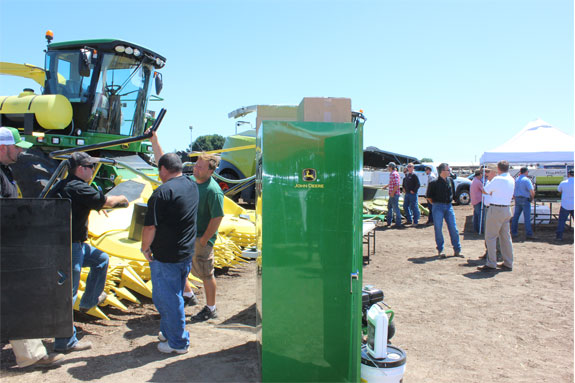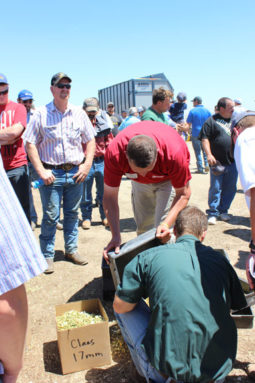Hosted by Mycogen Seeds and other allied industries at the Dan Peterson Dairy in Turlock, California, last month, the Chopper School featured silage chopping and packing demonstrations and a panel of custom harvesters discussing tips for silage harvest.
“The purpose of the Chopper School is to continue the conversation between the dairyman, custom harvester, crop consultant and nutritionist,” says Ashley Bush, Mycogen Seeds sales representative and organizer of the event.
“Over and over again, we find silage is chopped and managed most effectively when there is proper communication between these parties prior to harvest.”
Keith Bolsen, silage consultant and professor emeritus at Kansas State University, led a panel of custom harvesters who represent a significant share of California’s silage crop.
Members of the panel were Johnny Borba, Borba Dairy Farming; Dave Nunes, Aces Wild; Jeff Perry, Perry Custom Chopping; Frank Borba, Frank Borba and Son Chopping; Wiebren Jonkman, Diamond J Farms; Phil Vander Meulen, Vander Meulen Inc.; and Mitchell Bettencourt, Bettencourt Custom Farming.
The panelists advised dairy producers and other decision-makers to discuss these four topics prior to corn silage harvest:
- Timing. Discuss planting dates early in the season and estimate when fields will be ready for chopping. Confirm the chopping schedule two to five days prior to harvest.
- Chopping and packing. Know the estimated chopping rate (tons per hour) and determine if an extra pack tractor(s) is needed to achieve the silage density target. Decide if the dairy or contactor will provide the extra pack tractor and operator. Agree on the size and shape of the silage piles.
- Covering. Discuss who will be in charge of covering the bunker or pile and who will coordinate this activity with the covering contractor’s crew.
- Inoculants. Some custom harvesters apply an inoculant of their choice. The dairy producer should talk to the contractor several days in advance if the producer wants to select an inoculant.

Panelists also advised producers to check dry matter multiple times in each field during chopping and continually monitor forage particle size and kernel processing throughout the day.
If results are different than expected, advise the custom harvester’s crew boss while there is time to make the necessary adjustments.
Bolsen pointed out that about 20 percent of the corn silage in the country is lost to shrink every year at a steep price to dairy producers.
However, he believes it is possible to achieve a shrink loss of 10 percent or less in properly managed drive-over piles, and there are dairy producers out there doing it successfully.
Bolsen encouraged producers to make space available for drive-over piles, which are more efficient and safer than typical steep-sided, push-up piles.
In addition to Mycogen Seeds, sponsoring companies of Chopper School were Garton Tractor, Kemin, Krone California, N&S Tractor, Pfizer Animal Health, San Joaquin Equipment and Silostop.
“Our goal was to educate individuals on forage harvester features and silage management practices to help dairymen and other decision-makers reach their operations’ goals,” Bush says. FG
—From Mycogen Seeds news release
PHOTOS
TOP: Mycogen Seeds nutritionist Chris Dschaak evaluates silage chop length during harvest demonstrations at the 2012 Chopper School.
MIDDLE: Producers had ample opportunity to “talk silage” during the 2012 Chopper School. Photos courtesy of Mycogen Seeds.









